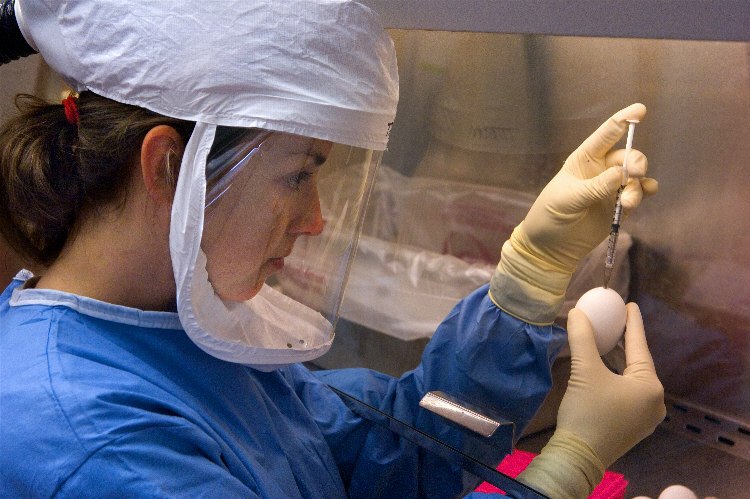

One year after voluntarily pausing their work on airborne bird flu, an international group of flu researchers wants to get back to it, promising safeguards that will protect lab workers and the public. The benefits of studying how avian flu can mutate to infect humans outweigh the risks, which the researchers say are minimal anyway. Now it’s a matter of getting government funding agencies to restore funding.
“We know that in nature, H5N1 viruses in birds are becoming more like viruses that affect mammals,” said Yoshihiro Kawaoka of the University of Wisconsin, Madison, co-signer of a new letter declaring an end to the research moratorium. He is also lead author of a paper examining genetic changes that can make the flu airborne. “The greater risk is not doing research that could help us to be better equipped to deal with a pandemic.”
The worldwide moratorium stemmed from a pair of papers examining genetic mutations that could make the bird flu easily transmissible among ferrets, the best animal model for how humans respond to flu. Scientists and government officials were worried the mutated virus could escape from the lab bench, infecting lab workers and the public and causing a pandemic. Biosecurity experts also feared the recipes for the potent, contagious flu could fall into the wrong hands. But scientists have addressed safety concerns and need to resume their work, the letter says. It is signed by 40 people from nine countries.
Resuming the research will help virologists understand how the flu adapts, and how scientists might have to fight it if it mutates to infect humans, said Benjamin tenOever, professor of microbiology at the Graduate School of Biomedical Sciences at Mount Sinai School of Medicine.
“The thing that makes their findings scary is the same thing that makes their research incredibly important,” he said.
Before everyone in the U.S. can get back to work, the National Institutes of Health must set new guidelines for the safety of this type of research. Members of the public can offer comments through Jan. 31, which means researchers should once again receive federal funds a few weeks after that. Some scientists in Europe and China can already proceed.
Avian flu is normally only transmitted among poultry and rarely from poultry to people, but it can’t move among mammals, at least not yet. To study how the virus might evolve this ability, Kawaoka and Ron Fouchier of the Erasmus Medical Center in the Netherlands induced several changes to its genetic makeup. In Kawaoka’s experiment, researchers combined elements of the H5N1 flu with a human flu, the 2009 H1N1 “swine flu” that caused an epidemic. They figured out which mutations would help the bird virus shift to a variant that would thrive in humans. Read more about his experiment here. In Fouchier’s experiment, researchers changed three amino acids to make the virus adapt to mammalian cells, and then infected several groups of ferrets. In both cases, the ferrets got sick. You can learn more about his methods here.
Notably–and absent from much of the discussion about this research–the ferrets didn’t die, at least not until they were directly injected with massive doses of the virus. That’s interesting because it suggested the changes that made the virus airborne and mammal-specific also made it less potent. Nobody would have known any of this without the ability to modify and study flu variants, tenOever said. Understanding the enemy is a major step toward defeating it.
While some scientists remain concerned about biosafety, many say the moratorium only served to delay important research. And it may have even broader implications for microbiology generally. Dual-use research of concern, which means scientific research that could also be misused for malicious purposes, is increasingly difficult to define, many scientists argue. TenOever said he’s noticing a trend toward more restrictions and added caution in research areas that would not normally be so closely scrutinized, which adds to researchers’ procedural hurdles and could limit scientific gains.
Part of this is due to fears that lab-modified pathogens could leapfrog evolution, unleashing powerful disease agents that nature would not have created. But tenOever, and many others, argue this is misguided.
“It would be arrogant of us as humans to think that we could, in a few weeks’ time, design something better than millions of years of evolution has already done,” he said. ”The fact is, the worst things that can possibly be out there are already out there, and have already been designed.”
Now that their self-imposed moratorium is over, virologists will start conducting new experiments to understand the minimum number of genetic changes required to make the virus airborne. They also want to increase surveillance, monitoring birds around the world to understand which versions of the virus are causing outbreaks in which places. Lab research should resume in Europe within a few weeks, Fouchier said, adding: “We’ll have to order more ferrets.”
The letter is jointly published in the leading journals Science and Nature. You can read it, along with other documents explaining scientists’ debates about this issue, by clicking here.

